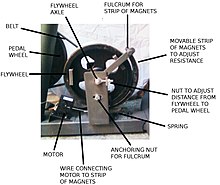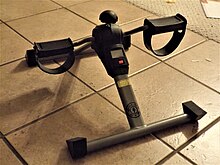Stationary bicycle
 From Wikipedia - Reading time: 5 min
From Wikipedia - Reading time: 5 min
This article needs additional citations for verification. (November 2016) |



A stationary bicycle (also known as exercise bicycle, exercise bike, spinning bike, spin bike, or exercycle) is a device used as exercise equipment for indoor cycling. It includes a saddle, pedals, and some form of handlebars arranged as on a (stationary) bicycle.[1][2]
A stationary bicycle is usually a special-purpose exercise machine resembling a bicycle without wheels.[citation needed] It is also possible to adapt an ordinary bicycle for stationary exercise by placing it on bicycle rollers or a trainer. Rollers and trainers are often used by racing cyclists to warm up before racing, or to train on their own machines indoors.
History
[edit]The ancestors of modern stationary bicycles date back to the end of the eighteenth century. The Gymnasticon was an early example.
Types
[edit]Some stationary bike models feature handlebars that are connected to the pedals so that the upper body can be exercised along with the lower body. Most exercise bikes come with mechanisms to apply resistance to the pedals, enhancing the intensity of the exercise. Resistance mechanisms include magnets, fans, and friction mechanisms. Some models allow the user to pedal backwards to exercise antagonist muscles which are not exercised in forward pedaling. Exercise bicycles are typically manufactured using a crankshaft and bottom bracket, which turns a flywheel by means of a belt or chain. The bearings on these moving parts wear with use and may require replacement.
Specialized indoor bicycles manufactured using a weighted flywheel at the front are used in the indoor cycling exercises called spinning.
Various types of indoor mini-cycles (also known as exercise pedallers) have also developed as portable, inexpensive alternatives to traditional stationary bicycles.[3] They are useful when exercisers are unable to access their stationary bicycles from their homes or local gyms when travels or at work.

Uses
[edit]Exercise bikes are used for exercise, to increase general fitness, for weight loss, and for training for cycle events. The exercise bike has long been used for physical therapy because of the low-impact, safe, and effective cardiovascular exercise it provides. The low-impact movement involved in operating an exercise bike does not put much stress on joints and does not involve sporadic motions that some other fitness equipment may require.[citation needed] However, as with typical biking, extended use of a stationary bike has been linked to decreased sexual function.[4]
Stationary bikes are also used for physical testing, i.e. as ergometers for measuring power. Traditionally this is done by imposing a certain level of resistance mechanically and/or measuring this.[5] gives a good overview. Modern ergometers and even many consumer exercise bikes are fitted with electronic sensors and displays.
Ergometers, such as CEVIS (Cycle Ergometer with Vibration Isolation and Stabilization System), are used in space (e.g. in the ISS) to counter cardiovascular deconditioning in the microgravity environment.[6]
Exercise bikes are frequently used in cardiac rehabilitation programs to help individuals recover from heart-related conditions or surgeries. The controlled and adjustable nature of stationary biking makes it an ideal choice for gradually improving cardiovascular health after cardiac events.[7]
Mini-cycles provide low-intensity exercise that helps users "burn calories, combat cholesterol, help moderate blood sugar levels, provide gentle toning, keep joints mobile through gentle use, and improve general circulation." They are also often used by people for rehabilitation purposes after suffering physical injuries.[citation needed]
See also
[edit]References
[edit]- ^ "What Are the Health Benefits of Routinely Riding a Stationary Bike?". livehealthy.chron.com. Retrieved 2019-07-22.
- ^ Sarnataro, Barbara Russi. "Fitness Basics: The Exercise Bike Is Back". WebMD. Retrieved 2019-07-22.
- ^ Thompson, Van. "The Fastest Way to Lose Weight While Using a Mini Stationary Bike". Chron. Hearst Newspapers, LLC. Retrieved 9 March 2019.
- ^ Simon, Harvey B. (14 September 2012). "Biking and sex—avoid the vicious cycle". Harvard Health Blog. Harvard University. Retrieved 14 November 2016.
- ^ Vandewalle, Henry; Driss, Tarak (2015). "Friction-loaded cycle ergometers: Past, present and future" (PDF). Cogent Engineering. 2. doi:10.1080/23311916.2015.1029237. S2CID 46022112. Retrieved 23 November 2017.
- ^ "Cycle Ergometer with Vibration Isolation and Stabilization System (CEVIS)". www.nasa.gov. NASA. Retrieved 14 November 2016.
- ^ Gloc, D.; Nowak, Z.; Nowak-Lis, A.; Gabryś, T.; Szmatlan-Gabrys, U.; Valach, P.; Pilis, A. (2021). "Indoor cycling training in rehabilitation". BMC Sports Science, Medicine & Rehabilitation. 13 (1): 151. doi:10.1186/s13102-021-00379-w. PMC 8628460. PMID 34844646.
 KSF
KSF